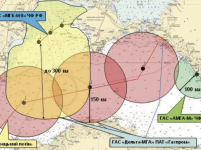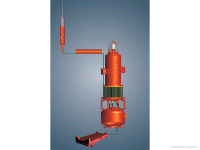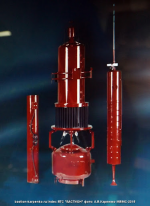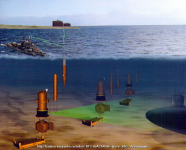The article claims "Turkish stream pipeline" turns out Russian secret weapon!
@Anmdt What would you say about this? Is it possible to use pipelines as spy tool?
Another question Do we need cover our coastal lines with those hydroacoustic systems?
Russia's Secret Weapons in the Black Sea: Hydroacoustic Systems That Spy on Us
Information and consulting company that covers issues of defense-industrial policy, military-technical cooperation, as well as defense and security policy of the state.
View attachment 23491
The Russian Federation secretly creates a new threat "from under the water", preparing an underwater foothold for total control over the Black Sea. The development of an echeloned system of illumination of the surface and underwater situation is carried out with the help of the production and implementation of the latest hydroacoustic systems.
This conclusion is made by the authors of a detailed analytical work entitled "Underwater Space of the Ukrainian Sea: Challenges and Threats". On July 10, this publication was published in the new issue of the Black Sea Security magazine, published by the Center for Global Studies "Strategy XXI".
We present for your acquaintance an interesting analysis of Russian hydroacoustic systems, which are being actively developed and used by the military leadership of the Russian Federation in the oceanic operational zone (first line); the far maritime operational zone (second line) and the near maritime operational zone (third line).
It is at the third stage that the coverage of the situation near the territorial waters of the Russian Federation is carried out, although in the context of the annexed Crimea, of course, this acquires a different interpretation.
So, what exactly is Russia using in the Black Sea region?
Passive sonar complex MGK-608
In the northwestern part of the Black Sea, starting in 2019, the placement of the MGK-608 stationary passive sonar complex has begun. A feature of this complex is that the installation of hydroacoustic buoys (antennas) is carried out at a distance of up to 200 kilometers from the coastline, and the detection radius is about 100-150 miles.
View attachment 23485
Defense Express
View attachment 23490
The transmission of data on the situation will be carried out via fiber-optic communication channels to the information processing and analysis point.
The transmission of data on the situation will be carried out via fiber-optic communication channels to the information processing and analysis point.
After the deployment of the hydroacoustic field from Cape Tarkhankut, probably to the area east of Zmeiny Island, the Russian Federation will be able to fully control the surface and underwater situation in the northwestern and western waters of the Black Sea.
Stationary hydroacoustic complex "Rationality VG-5"
Also, to determine the surface and underwater situation, both in the near sea operating zone and in the coastal zone of the Black Sea, a number of hydroacoustic systems have been deployed and will continue to be deployed, which will most likely also be integrated into the Unified State System of Surface and Underwater Situation Illumination.
We are talking about the stationary hydroacoustic complex "Rationality VG-5", designed for hydroacoustic reconnaissance and classification of underwater and surface targets (in sonar and noise direction finding modes), as well as to provide sound-conducting and acoustic telegraph communication with submarines and other objects in the open sea ...
RF secretly creates a new threat "from under the water"
As of today, it is known that the construction of the infrastructure of the control center for this complex is completed. Organizationally, it is part of the 14th observation area of the Novorossiysk naval base. In the future, the Russian Federation plans to deploy another such complex at Cape Sarych (temporarily occupied territory of the Autonomous Republic of Crimea).
Autonomous hydroacoustic stations "Amga-M"
Also, to determine the surface and underwater situation, the submarine detection system is used as part of the Amga-M autonomous hydroacoustic stations (AGAS), which are designed to search, detect, classify and track submarines, determine the direction of movement and transmit information about them to coastal or ship control points.
View attachment 23484
Defense Express
For the first time, such a submarine detection system in the number of twenty indicated stations was deployed at the beginning of 2014 in the sea area of the city of Sochi to ensure the safety of the Olympic Games. These measures made it possible to create an anti-submarine line with a length of up to one hundred kilometers and a width of up to six kilometers.
View attachment 23486
The stations can be controlled from a surface ship or a coastal control center using hydroacoustic communications, and the transmission of information from the AGAS about the detection of a submarine - by radio communications at a distance of up to sixty kilometers.
AGAS "Amga-M" provides a 360-degree field of view and can be anchored in areas with depths from 300 to 1500 meters. This ensures the hidden presence of the station at the position and of the entire submarine detection system as a whole.
Defense Express
View attachment 23488
Stationary electromagnetic station "Anaconda-SP"
The stationary electromagnetic station "Anaconda-SP" is designed to identify and classify underwater sabotage forces and assets (combat swimmers, unmanned underwater vehicles, etc.) at a distance of up to thirty kilometers.
The Russian Federation plans to commission two such stations, which will be located on the territory of the Autonomous Republic of Crimea. One - in the area of Cape Tarkhankut, the second - on Cape Chersonesos. The deployment of these stations will make it possible to strengthen the near defense zone of the Black Sea Fleet basing points, as well as critical civilian infrastructure, primarily from possible actions of submarine sabotage forces and assets.
Active magnetic acoustic station MG-818 "Diabaz"
To detect sabotage forces and assets in the near defense zone of basing points and other objects of the naval infrastructure, the Russian Federation plans to use the MG-818 "Diabaz" active magnetic-acoustic station (for detecting and classifying underwater sabotage forces and assets). Today, the combat capabilities of this station are being evaluated and the location of its further deployment is being determined.
AGAS "Amga-M", EMS "Anaconda-SP" and AMAS "Diabaz" are autonomous stations, which makes it possible to quickly deploy them in the Azov-Black Sea region. It is not ruled out that they can be used to protect the facilities seized by Russia at the gas fields of Chernomorneftegaz in the exclusive sea economic zone of Ukraine and the bridge over the Kerch Strait.
Defense Express
Delta-MGA system
During the period, during 2018-2019, tests and commissioning of the new Delta-MGA system were carried out, which is actively used in the interests of PJSC Gazprom (according to statements, in the interests of the safety of underwater gas pipelines). These hydroacoustic stations have been installed along the Turkish Stream gas pipeline.
The Russian Federation does not leave the prospect of building up hydroacoustic reconnaissance assets by placing them at the infrastructure facilities of the Blue Stream and Turkish Stream, which will practically lead to complete control of the underwater space of the Black Sea.
View attachment 23489
Thus, the Russian Federation secretly creates a new threat "from under the water", preparations are underway for an underwater bridgehead as an element of total control over the Black Sea and the transfer of the upcoming confrontation not only into space, but also under water.
Yuri Bakai, Anatoly Burgomistrenko, Sergey Gaiduk
Тайное оружие России в Черном море - гидроакустические системы, которые шпионят за нами - Defense Express : Тайное оружие России на Черном море: Гидроакустические системы, которые шпионят за нами - новости ZIKUA.TV







